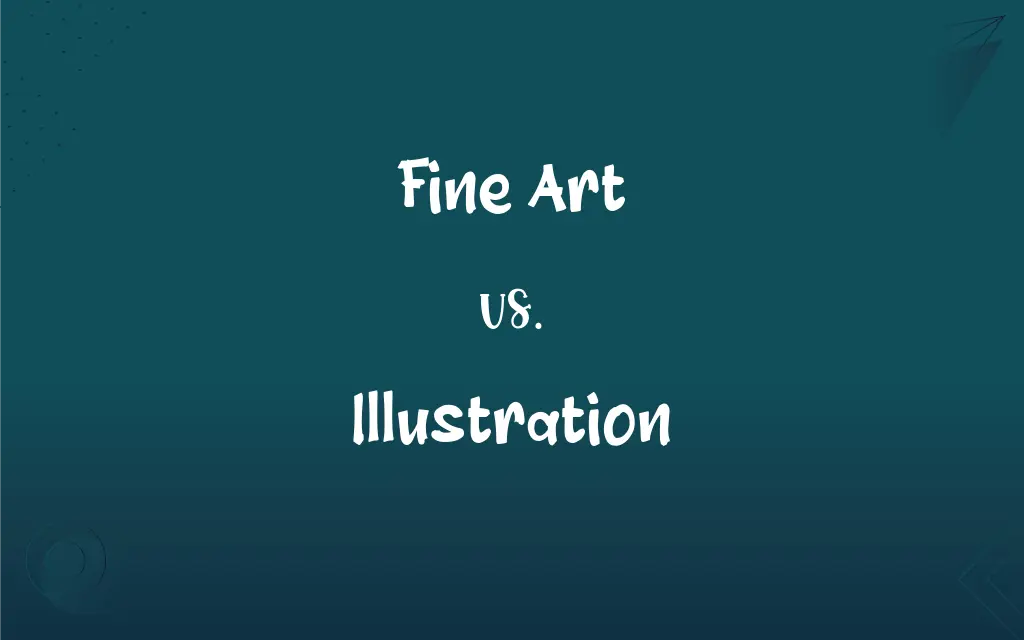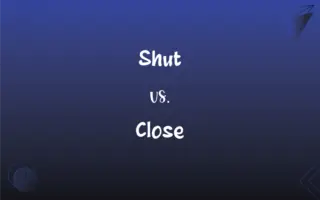Fine Art vs. Illustration: What's the Difference?
Edited by Aimie Carlson || By Harlon Moss || Published on December 2, 2023
Fine art is creative art, especially visual art, valued primarily for its aesthetic or expressive nature, while illustration is the depiction of a subject to complement, explain, or visually interpret text or concepts.

Key Differences
Fine art is often created for aesthetic, intellectual, or purely artistic purposes, focusing on the expression and creative vision of the artist. Illustration, in contrast, is typically created to serve a specific function, such as explaining or enhancing textual content.
Fine art includes mediums like painting, sculpture, and printmaking, often displayed in galleries and museums. Illustration is commonly found in books, magazines, and digital media, aiming to visually represent or clarify concepts.
The value of fine art is frequently determined by its originality, artistic merit, and the artist's reputation. Illustration, however, is valued for its ability to communicate a message or complement a narrative effectively.
Fine art is subjective and open to interpretation, encouraging viewers to engage emotionally and intellectually. Illustration is more objective, designed to be clear and direct in conveying its intended message.
Fine art is often a reflection of the artist's personal experiences, ideas, and emotions. Illustration usually aligns with the goals of the client or the needs of the target audience, often in commercial or educational contexts.
ADVERTISEMENT
Comparison Chart
Purpose
Aesthetic and expressive
Functional, explanatory
Medium
Painting, sculpture, printmaking
Drawings in books, media, advertising
Value Determined By
Originality, artistic merit
Ability to communicate effectively
Interpretation
Subjective, open to interpretation
Objective, clear, and direct
Context
Galleries, personal expression
Commercial, educational, accompanying text
ADVERTISEMENT
Fine Art and Illustration Definitions
Fine Art
Artistic works considered to have been created primarily for beauty or to express ideas.
Fine art like abstract paintings challenges conventional perceptions of reality.
Illustration
Artwork created to serve a specific function, often to explain or decorate text.
The medical textbook was complemented by detailed anatomical illustrations.
Fine Art
Art forms developed primarily for aesthetics or concept rather than utility.
The exhibition showcased fine art from various contemporary artists.
Illustration
The action or process of illustrating something.
Her illustration of the concept made the complex topic easily understandable.
Fine Art
Creative art, particularly visual art, valued for its beauty or emotional power.
The museum's collection of fine art spans several centuries.
Illustration
A visual explanation or depiction in a book, magazine, or digital media.
The children's book was brought to life with vibrant illustrations.
Fine Art
The study and creation of visually aesthetic or conceptually driven works.
He pursued a degree in fine art to explore his passion for painting.
Illustration
An example serving to clarify or prove something.
The diagram served as an illustration of the scientific theory.
Fine Art
Art created primarily for aesthetic or intellectual purposes.
Her fine art pieces often provoke deep thought and discussion.
Illustration
The creation of images to visually represent or accompany written material.
He specializes in illustration for advertising campaigns.
Illustration
The act of illustrating or the state of being illustrated
Concepts that would benefit from illustration.
An idea that lends itself to illustration.
Illustration
A picture or image that is used to decorate or clarify a text.
FAQs
How do fine art and illustration differ in context?
Fine art is often found in galleries and personal collections, while illustrations are commonly seen in books, magazines, and advertisements.
Can illustration be considered fine art?
Sometimes, especially when it transcends its functional role and is appreciated for its artistic qualities.
Can illustration be digitally created?
Yes, digital illustration is a common and growing field.
What mediums are common in fine art?
Common mediums include painting, sculpture, and printmaking.
Where do we typically find illustration?
Illustrations are typically found in books, magazines, digital media, and advertising.
What defines fine art?
Fine art is defined by its aesthetic and expressive qualities, focusing on beauty and creative expression.
What is the primary purpose of illustration?
Illustration primarily aims to visually explain, interpret, or complement text or concepts.
Do fine artists work on commission?
Some do, but fine art is often created independently of specific commercial objectives.
Do illustrators work with authors or editors?
Often, illustrators collaborate with authors, editors, or designers to achieve a desired outcome.
How is the value of fine art determined?
It's determined by factors like originality, artistic merit, and sometimes the artist's reputation.
Is fine art always original?
Fine art is often original or unique, but it can also include limited editions or prints.
What skills are important for an illustrator?
Skills like drawing, understanding of design principles, and the ability to convey messages visually are key.
Are there different styles of fine art?
Yes, there are numerous styles, ranging from realism to abstract art.
Is fine art a good investment?
It can be, but like any investment, it carries risk and depends on market trends.
Can illustrations be narrative?
Yes, many illustrations tell a story or are part of a narrative, especially in children's books.
How important is creativity in illustration?
Creativity is crucial in illustration to effectively convey ideas and engage the audience.
Is there a difference in audience for fine art and illustration?
Yes, fine art often appeals to art collectors and enthusiasts, while illustrations target a broader audience, including readers and consumers.
Can fine art convey a message?
Yes, though its message is often more open to interpretation than in illustration.
Do fine artists require formal education?
While not always necessary, formal education can provide valuable skills and networking opportunities.
Is illustration considered a commercial art?
Yes, illustration is often considered a part of commercial art due to its application in marketing and media.
About Author
Written by
Harlon MossHarlon is a seasoned quality moderator and accomplished content writer for Difference Wiki. An alumnus of the prestigious University of California, he earned his degree in Computer Science. Leveraging his academic background, Harlon brings a meticulous and informed perspective to his work, ensuring content accuracy and excellence.
Edited by
Aimie CarlsonAimie Carlson, holding a master's degree in English literature, is a fervent English language enthusiast. She lends her writing talents to Difference Wiki, a prominent website that specializes in comparisons, offering readers insightful analyses that both captivate and inform.






































































